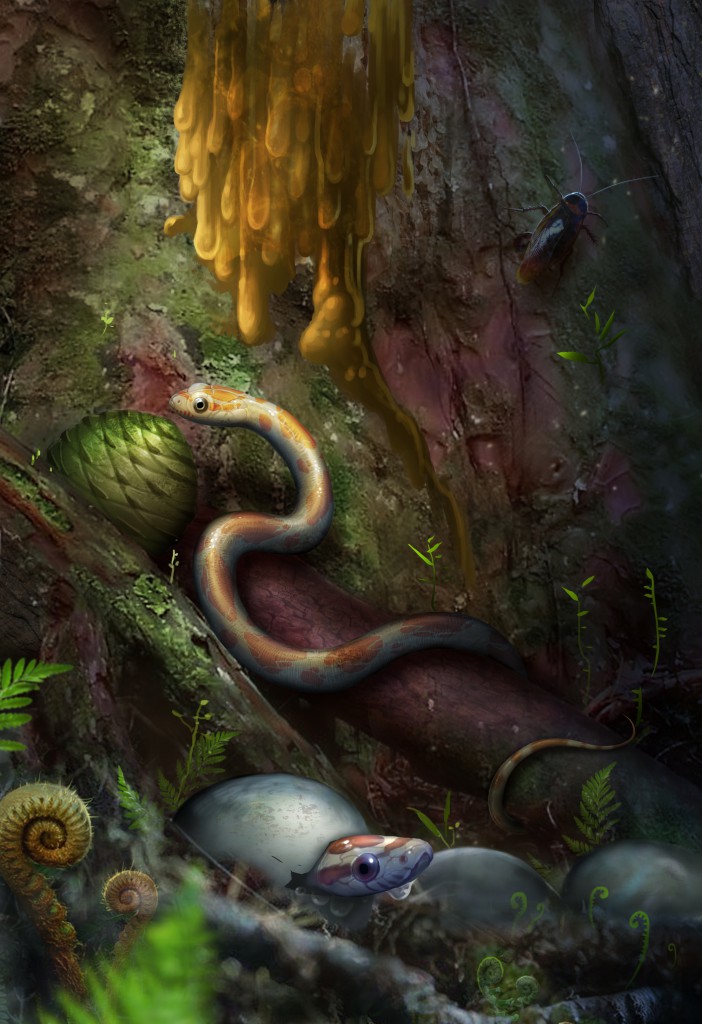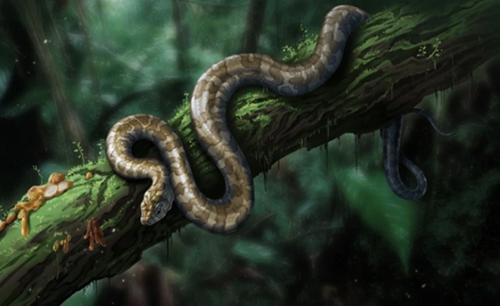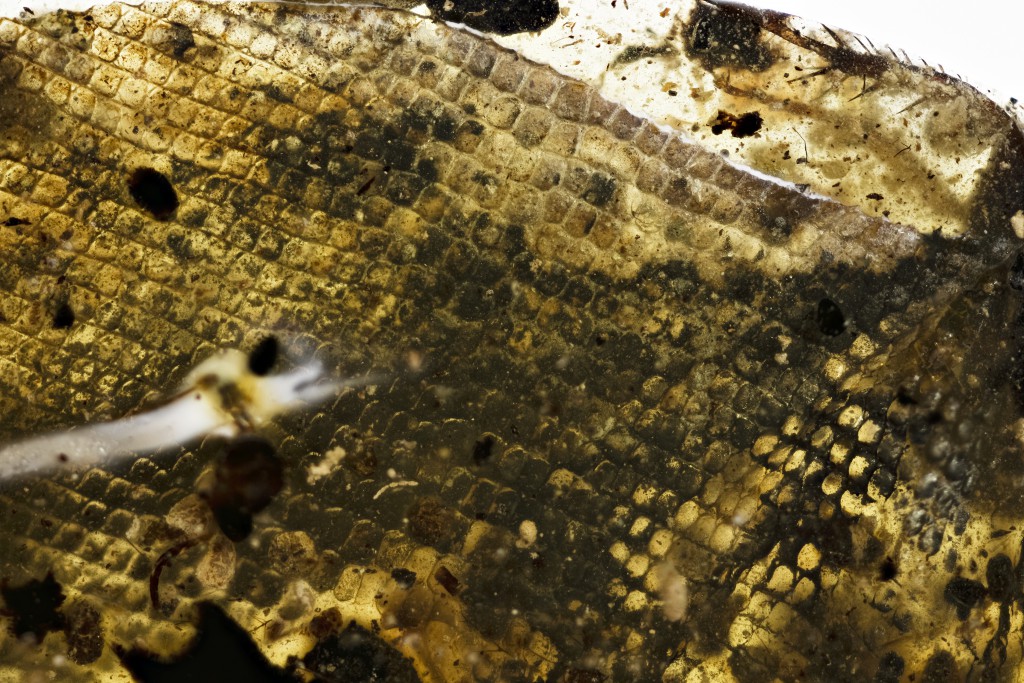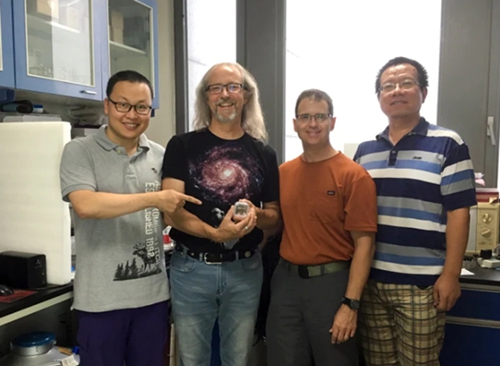
Researchers also find snakeskin with preserved light and dark colour markings

The skeletal remains of a snake embryo or hatchling are shown trapped in a piece of Burmese amber. The fossil doesn't include the head and is a total length of less than five centimetres. ( Ming Bai/Chinese Academy of Sciences)
A hundred million years ago, in the steamy Cretaceous rainforests of Myanmar, dinosaurs and lizards scampered, birds and insects flitted, and — now we know — snakes slithered and coiled among the trees.
From that ancient forest, scientists have found the first ever fossilized baby snake, beautifully preserved in ancient amber.

An illustration shows baby snakes emerging from their eggs on the floor of the amber-producing forest of Myanmar 99 million years ago. (Yi Liu)
"It's spectacular to have a baby snake in the fossil record because, of course, they'd be such tiny, delicate things," said Michael Caldwell, a biology professor at the University of Alberta who called the discovery "beyond exciting."
Caldwell co-authored a study published Wednesday in the journal Science Advances that describes the baby snake, as well as another amazing find: a piece of snakeskin shed by a much larger snake that preserves some of its original light and dark patterning.
Together, they provide the first evidence of snakes living in forests this early in their evolution — at a time when a huge variety of dinosaurs thrived. (Other snake fossils of the same age have been found in deserts.) They also help show how snakes developed and spread around the globe.
The fossils were found in 99-million-year-old amber deposits that have already yielded other amazing treasures, including dinosaur feathers, baby birds and lizards, along with the usual insects and plants typically found in amber.
After being mined in Myanmar, the amber is often sold to Chinese collectors and museums.

This is the inferred pattern of light and dark pigmentation on the larger snake, based on a skin fragment found in Burmese amber. (Yi Liu)
Lida Xing, the lead author of the new paper, is an associate professor and paleontologist at the Beijing-based China University of Geosciences, who makes frequent trips to Myanmar in search of interesting amber fossils. He is currently in that country and without reliable phone access, but described in an email how he found the snake fossils.
Mistaken identities
An amber dealer approached him in early 2016, saying he had found the skin of a crocodile.
But when Xing visited his booth at the market and saw the diamond shape of the scales, he recognized it as a snake — something that had never been found in the hundreds of thousands of fossils from those amber deposits.
"This is a big deal," he wrote.

A dealer told researcher Lida Xing that he had a specimen containing a crocodile skin. But Xing recognized it as a snake from the diamond-shaped scales. (Ryan McKellar/Royal Saskatchewan Museum)
Xing met Caldwell while Xing was doing his master's degree at the University of Alberta between 2010 and 2012. Since Caldwell was an expert in reptiles, Xing proposed collaborating on a study of the snakeskin.
As Xing was about to board a flight to Edmonton, he got a phone call from a group of Chinese fossil hunters about another specimen thought to be a huge centipede or millipede. It turned out to be something even more extraordinary — the tiny snake.
After Xing confirmed that's what it was, the fossil hunters, described by Xing as "citizen scientists," bought the fossil.
The head was missing, but the rest of the body was largely intact, allowing researchers to do CT scans to reveal the details of each bone.
Some snakes give birth to live young, including those found to be most closely related to the fossilized baby snake, such as the red-tailed pipe snakes of Southeast Asia. Others lay soft, leathery eggs that are not easily preserved and haven't been found in the fossil record to date.
In the case of the baby snake fossil, the researchers aren't sure whether it is an embryo or a newborn, or whether it was a live birth or hatched from an egg.
Sea amber
What's clear is that something unfortunate happened very early in the snake's life, and it ended up completed immersed in a blob of tree sap. When the sap hit the forest floor, it picked up all kinds of other material — like "bugs and plants and cockroach poop," Caldwell said — that provide valuable information about the ecosystem where the snake lived.
During floods, amber floats and then gets washed into rivers and eventually the sea.
"There are literally tens of thousands of these little amber blobs," said Caldwell. "They collect together like plastic debris, I guess, on the edge of a beach and they get covered up by beach sands."
That's how they end up embedded in sandstone deposits like the ones mined in Myanmar.
The researchers don't know how big the baby snake would have grown had it survived, but Caldwell estimates that it probably would have been about a metre long.
The new snake species has been given the name Xiaophis myanmarensis, which means "dawn snake of Myanmar."

Xiao Jia, a Chinese amber specialist, holds the amber fossil of the baby snake that she donated to the Dexu Institute of Paleontology. The snake has been named Xiaophis myanmarensis in her honour. (Lida Xing/China University of Geosciences Beijing)
The name also honours Xiao Jia, the amber specialist who donated the specimen to the Dexu Institute of Paleontology, the museum in Chaozhou, China that now houses the baby snake. She was a member of the group that originally called Xing about the fossil.
As for the snakeskin, Caldwell estimates it was shed from a snake about as long as a baguette and "quite big around," but it's impossible to tell what kind of snake it was.
In addition to Caldwell and Xing, the study also involved other researchers from Canada, China, the U.S. and Australia. It was funded by the National Science Fund of China, the U.S. National Geographic Society, the Fundamental Research Funds for the Central Universities of China, the Chinese Academy of Science, the Shanghai Synchrotron Radiation Facility, the Natural Sciences and Engineering Research Council of Canada, and the Australian Research Council. (CBC)

Research team members, from left to right: Lida Xing, Michael Caldwell, Randall Nydam, and Ming Bai, along with the baby snake fossil. (Shenna Wang)

86-10-68597521 (day)
86-10-68597289 (night)

86-10-68511095 (day)
86-10-68512458 (night)

cas_en@cas.cn

52 Sanlihe Rd., Xicheng District,
Beijing, China (100864)

